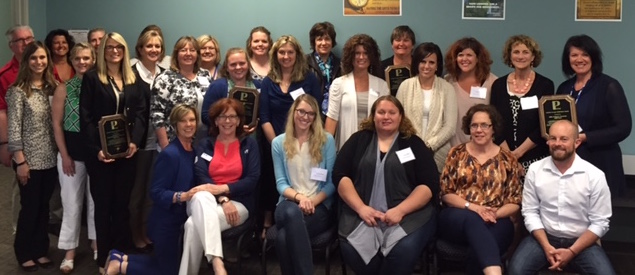The term Blended Learning is all abuzz in the world of education — and why shouldn’t it be? Our students were born into a digital age, and using technology comes naturally to them. So it only makes sense to use it in our daily lesson plans to give students opportunities to explore online content, allow new forms of expression and displays of content knowledge, and to connect with other students from all around the world.
 While we are enthusiastic about engaging our students by implementing technology into our teaching, we must remember Universal Design for Learning. This makes it important to ask yourself — How will I make my blended learning environment, content, and activities accessible to every student in my classroom? Will students who have visual, hearing, motor, and/or cognitive needs have the ability to access my curriculum just like my other students?
While we are enthusiastic about engaging our students by implementing technology into our teaching, we must remember Universal Design for Learning. This makes it important to ask yourself — How will I make my blended learning environment, content, and activities accessible to every student in my classroom? Will students who have visual, hearing, motor, and/or cognitive needs have the ability to access my curriculum just like my other students?

Well, making that content accessible without practice is no easy task, and intentional planning is necessary, but I assure you it can be done!
We know that images and videos increase interest in our content and that many students are visual learners. Yet, in order to make these features accessible to all students, videos should be closed-captioned and images should have alternative text (allowing a screen reader to read a short description of the image).
Fancy fonts can be fun to use, but sticking to a minimum 12-point font size in fonts such as Arial, Helvetica, or Verdana is preferred. These types of fonts, known as sans serif fonts, can be easily magnified for students with low vision.
Format your documents with the tools given to you in the program you are using. Avoid using multiple spaces for indenting, creating your own spacing for bullet points, or using text boxes as screen readers will not read these elements correctly.
I personally love color-coding for my own use, but relying on using only color to convey meaning makes a document inaccessible for students who are colorblind, have low vision, or are blind.
Blinking and flashing content should be limited to no more than 3 seconds — if not completely eliminated – due to risk of headaches or seizures.
Check out http://webaim.org/intro/ and https://www.ada.gov/websites2.htm for additional guidelines on website accessibility that you can translate into accessibility standards for your content. I expect to find new rules coming down the pipeline over the next few years that will mandate specific accessibility features in state and federal government websites, which includes K-12 public schools and public universities. This could certainly affect how your content is being delivered to your students as well as the content itself.
In the meantime, making a conscious effort to ensure all of your students have access to the curriculum, will only make following the future rules that much easier. And, of course, we are always here to help you along the way.


Well, making that content accessible without practice is no easy task, and intentional planning is necessary, but I assure you it can be done!
We know that images and videos increase interest in our content and that many students are visual learners. Yet, in order to make these features accessible to all students, videos should be closed-captioned and images should have alternative text (allowing a screen reader to read a short description of the image).
Fancy fonts can be fun to use, but sticking to a minimum 12-point font size in fonts such as Arial, Helvetica, or Verdana is preferred. These types of fonts, known as sans serif fonts, can be easily magnified for students with low vision.
Format your documents with the tools given to you in the program you are using. Avoid using multiple spaces for indenting, creating your own spacing for bullet points, or using text boxes as screen readers will not read these elements correctly.
I personally love color-coding for my own use, but relying on using only color to convey meaning makes a document inaccessible for students who are colorblind, have low vision, or are blind.
Blinking and flashing content should be limited to no more than 3 seconds — if not completely eliminated – due to risk of headaches or seizures.
Check out http://webaim.org/intro/ and https://www.ada.gov/websites2.htm for additional guidelines on website accessibility that you can translate into accessibility standards for your content. I expect to find new rules coming down the pipeline over the next few years that will mandate specific accessibility features in state and federal government websites, which includes K-12 public schools and public universities. This could certainly affect how your content is being delivered to your students as well as the content itself.
In the meantime, making a conscious effort to ensure all of your students have access to the curriculum, will only make following the future rules that much easier. And, of course, we are always here to help you along the way.


 1. The PATINS AEMing for Achievement Grant. This is a year-long collaboration between your entire district (represented by a small team) and PATINS-ICAM staff. This 15-16 school year had 8 teams and we JUST finished up on Friday with a day of collaboration and sharing successes and struggles of the year and I honestly tell you that it's the most inspirational day of my whole year! Incredible! Success stories of student's lives literally changing for the better evidenced in video and data. ANYWAY... I will be posting the application for NEXT YEAR's district teams THIS WEEK! The purpose of this grant is EXACTLY what I stated above; to assist your district with the the right processes, policies, procedures, workflow, and training to ensure that ALL STUDENTS have the materials they need in a "Timely Manner." Regardless of where you feel your district is now, we can help you to get this tall order accomplished over the next school year. We've done it.
1. The PATINS AEMing for Achievement Grant. This is a year-long collaboration between your entire district (represented by a small team) and PATINS-ICAM staff. This 15-16 school year had 8 teams and we JUST finished up on Friday with a day of collaboration and sharing successes and struggles of the year and I honestly tell you that it's the most inspirational day of my whole year! Incredible! Success stories of student's lives literally changing for the better evidenced in video and data. ANYWAY... I will be posting the application for NEXT YEAR's district teams THIS WEEK! The purpose of this grant is EXACTLY what I stated above; to assist your district with the the right processes, policies, procedures, workflow, and training to ensure that ALL STUDENTS have the materials they need in a "Timely Manner." Regardless of where you feel your district is now, we can help you to get this tall order accomplished over the next school year. We've done it. 